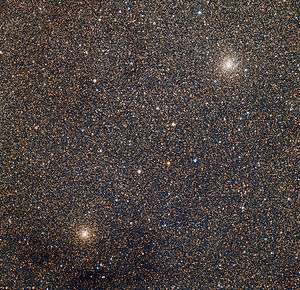NGC 6522
| NGC 6522 | |
|---|---|
|
32 inch telescope NGC 6528 (lower left) and NGC 6522 (upper right) | |
| Observation data (J2000 epoch) | |
| Constellation | Sagittarius |
| Right ascension | 18h 3m 34.1s[1] |
| Declination | −30° 2′ 2.3″[1] |
| Distance | 25.1 kly (7.7 kpc)[2] |
| Apparent magnitude (V) | 10.5 |
| Apparent dimensions (V) | 2' |
| Physical characteristics | |
| Mass | 3.00×105[2] M☉ |
| Metallicity | = –1.34[2] dex |
| Estimated age | 12.0 Gyr[3] |
NGC 6522 is a globular cluster in the constellation Sagittarius. It is apparent magnitude 10.5, and diameter 2 arc seconds, and class VI with stars 16th magnitude and dimmer. It was discovered by William Herschel on June 24, 1784. It is centered in a region of the sky known as Baade's Window.[1]
NGC 6522 is possibly the oldest star cluster in the Milky Way,[4] with an age of more than 12 billion years.[5]
References
- 1 2 3 "SIMBAD Astronomical Database". Results for NGC 6522. Retrieved 2011-03-13.
- 1 2 3 Boyles, J.; et al. (November 2011), "Young Radio Pulsars in Galactic Globular Clusters", The Astrophysical Journal, 742 (1): 51, arXiv:1108.4402
 , Bibcode:2011ApJ...742...51B, doi:10.1088/0004-637X/742/1/51.
, Bibcode:2011ApJ...742...51B, doi:10.1088/0004-637X/742/1/51. - ↑ Koleva, M.; et al. (April 2008), "Spectroscopic ages and metallicities of stellar populations: validation of full spectrum fitting", Monthly Notices of the Royal Astronomical Society, 385 (4): 1998–2010, arXiv:0801.0871
 , Bibcode:2008MNRAS.385.1998K, doi:10.1111/j.1365-2966.2008.12908.x
, Bibcode:2008MNRAS.385.1998K, doi:10.1111/j.1365-2966.2008.12908.x - ↑ "VLT-FLAMES Analysis of 8 giants in the Bulge Metal-poor Globular Cluster NGC 6522: Oldest Cluster in the Galaxy?" by B. Barbuy et al., 2009
- ↑ "The universe's first stars were whirling dervishes", New Scientist by David Shiga, 30 April 2011, p. 20. "Imprints of fast-rotating massive stars in the Galactic Bulge" by Cristina Chiappini et al., Nature 472, pp. 454–457 (28 April 2011).
External links
This article is issued from Wikipedia - version of the 12/3/2016. The text is available under the Creative Commons Attribution/Share Alike but additional terms may apply for the media files.
